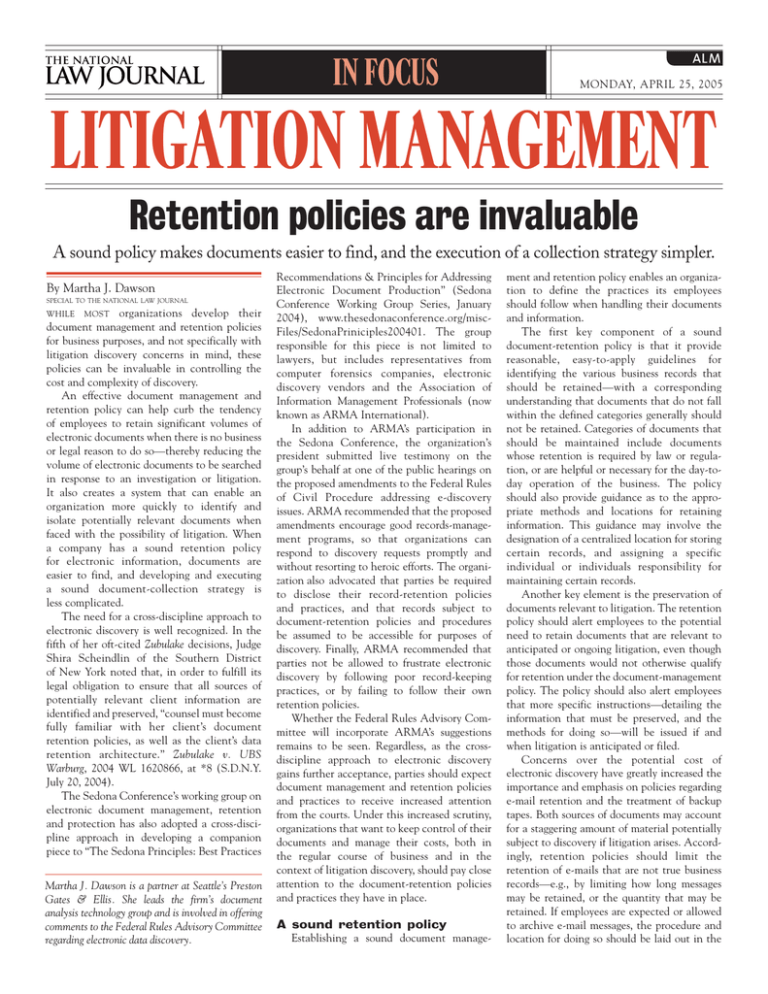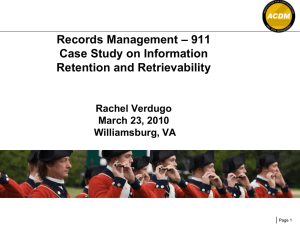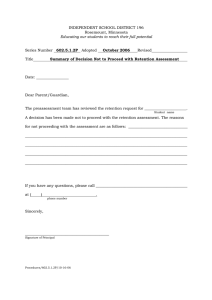
IN FOCUS
MONDAY, APRIL 25, 2005
LITIGATION MANAGEMENT
Retention policies are invaluable
A sound policy makes documents easier to find, and the execution of a collection strategy simpler.
By Martha J. Dawson
SPECIAL TO THE NATIONAL LAW JOURNAL
MOST organizations develop their
document management and retention policies
for business purposes, and not specifically with
litigation discovery concerns in mind, these
policies can be invaluable in controlling the
cost and complexity of discovery.
An effective document management and
retention policy can help curb the tendency
of employees to retain significant volumes of
electronic documents when there is no business
or legal reason to do so—thereby reducing the
volume of electronic documents to be searched
in response to an investigation or litigation.
It also creates a system that can enable an
organization more quickly to identify and
isolate potentially relevant documents when
faced with the possibility of litigation. When
a company has a sound retention policy
for electronic information, documents are
easier to find, and developing and executing
a sound document-collection strategy is
less complicated.
The need for a cross-discipline approach to
electronic discovery is well recognized. In the
fifth of her oft-cited Zubulake decisions, Judge
Shira Scheindlin of the Southern District
of New York noted that, in order to fulfill its
legal obligation to ensure that all sources of
potentially relevant client information are
identified and preserved, “counsel must become
fully familiar with her client’s document
retention policies, as well as the client’s data
retention architecture.” Zubulake v. UBS
Warburg, 2004 WL 1620866, at *8 (S.D.N.Y.
July 20, 2004).
The Sedona Conference’s working group on
electronic document management, retention
and protection has also adopted a cross-discipline approach in developing a companion
piece to “The Sedona Principles: Best Practices
WHILE
Martha J. Dawson is a partner at Seattle’s Preston
Gates & Ellis. She leads the firm’s document
analysis technology group and is involved in offering
comments to the Federal Rules Advisory Committee
regarding electronic data discovery.
Recommendations & Principles for Addressing
Electronic Document Production” (Sedona
Conference Working Group Series, January
2004), www.thesedonaconference.org/miscFiles/SedonaPriniciples200401. The group
responsible for this piece is not limited to
lawyers, but includes representatives from
computer forensics companies, electronic
discovery vendors and the Association of
Information Management Professionals (now
known as ARMA International).
In addition to ARMA’s participation in
the Sedona Conference, the organization’s
president submitted live testimony on the
group’s behalf at one of the public hearings on
the proposed amendments to the Federal Rules
of Civil Procedure addressing e-discovery
issues. ARMA recommended that the proposed
amendments encourage good records-management programs, so that organizations can
respond to discovery requests promptly and
without resorting to heroic efforts. The organization also advocated that parties be required
to disclose their record-retention policies
and practices, and that records subject to
document-retention policies and procedures
be assumed to be accessible for purposes of
discovery. Finally, ARMA recommended that
parties not be allowed to frustrate electronic
discovery by following poor record-keeping
practices, or by failing to follow their own
retention policies.
Whether the Federal Rules Advisory Committee will incorporate ARMA’s suggestions
remains to be seen. Regardless, as the crossdiscipline approach to electronic discovery
gains further acceptance, parties should expect
document management and retention policies
and practices to receive increased attention
from the courts. Under this increased scrutiny,
organizations that want to keep control of their
documents and manage their costs, both in
the regular course of business and in the
context of litigation discovery, should pay close
attention to the document-retention policies
and practices they have in place.
A sound retention policy
Establishing a sound document manage-
ment and retention policy enables an organization to define the practices its employees
should follow when handling their documents
and information.
The first key component of a sound
document-retention policy is that it provide
reasonable, easy-to-apply guidelines for
identifying the various business records that
should be retained—with a corresponding
understanding that documents that do not fall
within the defined categories generally should
not be retained. Categories of documents that
should be maintained include documents
whose retention is required by law or regulation, or are helpful or necessary for the day-today operation of the business. The policy
should also provide guidance as to the appropriate methods and locations for retaining
information. This guidance may involve the
designation of a centralized location for storing
certain records, and assigning a specific
individual or individuals responsibility for
maintaining certain records.
Another key element is the preservation of
documents relevant to litigation. The retention
policy should alert employees to the potential
need to retain documents that are relevant to
anticipated or ongoing litigation, even though
those documents would not otherwise qualify
for retention under the document-management
policy. The policy should also alert employees
that more specific instructions—detailing the
information that must be preserved, and the
methods for doing so—will be issued if and
when litigation is anticipated or filed.
Concerns over the potential cost of
electronic discovery have greatly increased the
importance and emphasis on policies regarding
e-mail retention and the treatment of backup
tapes. Both sources of documents may account
for a staggering amount of material potentially
subject to discovery if litigation arises. Accordingly, retention policies should limit the
retention of e-mails that are not true business
records—e.g., by limiting how long messages
may be retained, or the quantity that may be
retained. If employees are expected or allowed
to archive e-mail messages, the procedure and
location for doing so should be laid out in the
THE NATIONAL LAW JOURNAL
document-retention policy. The policy should
establish backup tapes as a means of disaster
recovery only, and set an appropriate schedule
for recycling backup tapes to ensure they are
retained only as long as is necessary to provide
backup in the case of a system failure. Backup
tapes should never become a de facto archive;
rather, the archive should be represented by
documents properly retained pursuant to the
guidelines established in the retention policy.
Another critical element of a sound
document-retention policy is the inclusion of a
specific plan for implementation and execution. In order to implement, monitor and
enforce compliance with a policy, an organization has to commit resources to educate
employees about the policy and provide them
with the time, resources and incentives to both
organize their existing information, and to follow the policy going forward. An organization’s
failure to follow its formal document-retention
policies can have devastating consequences in
litigation if potentially relevant documents are
destroyed or unavailable as a result.
So how does a management and retention
policy assist the discovery process? The first
steps of the preservation and collection process
involve identifying what information is relevant, determining who has that information
and identifying where it is located. Well-crafted retention policies can dramatically lower
the volume of information that has been
retained and, accordingly, the volume that may
need to be identified, preserved and collected.
Just as importantly, by establishing protocols
for how and where information is retained,
policies encourage employees to save only
items of substance, and to save them in a
deliberate, consistent manner.
The result is a company of informed users
who are better positioned to provide answers to
key questions, and whose documents and information are likely to be stored in discrete locations. Much of the high-level information
needed for planning the preservation and collection process may actually be spelled out in
the retention policy itself. The policy should
include information about the organization’s
computer systems, including the hardware and
software used, how files are saved, what e-mail
system is used, what backup protocols are in
place, whether the organization possesses any
archival or legacy information, the organization’s document-retention policies and its
data-retention architecture. Discussions with
information technology (IT) personnel can be
used to fill in the details of the organization’s
electronic information systems.
Detailed information regarding the records
and record-retention habits of individual
custodians can be obtained by having the key
players involved in the matters surrounding the
litigation complete an interview or question-
MONDAY, APRIL 25, 2005
naire. The goal is to determine key aspects of
their personal retention practices, for example,
the software programs they use; where they
save documents, whether at the office or away;
and if and where they archive e-mail. To ensure
preservation measures are adequate, it is also
critical to ask key players about any servers
or file shares, over which they do not have
personal responsibility, but on which they or
others may save documents.
Litigation hold notices
Hand-in-hand with identifying and locating
the relevant information is ensuring it is
preserved. Litigation hold notices detailing
the information to be preserved—both on an
individual and systemwide level—must be
issued as soon as possible after litigation
is anticipated.
Litigation hold notices should be issued to
the key individuals who may have documents
They are issued very soon
after litigation is anticipated.
or information relevant to the litigation. The
notice should include information regarding
the general nature of the litigation, and the
subjects and time frame of potential relevance
in the litigation. The notice should also
explain that the recipient has been identified as
someone who may have documents or information relevant to matters at issue in the litigation, instruct the recipient that he or she must
not delete or destroy any documents relevant to
these matters until notified otherwise and
provide specific instructions regarding any
special steps that the recipient should take to
preserve relevant information.
Steps must also be taken to preserve
relevant material on a systemwide level—i.e.,
to protect relevant information that is stored in
a location not under the control of an individual. Such locations may be under the control of
a specific person, or the organization’s IT
department. Determining who is the custodian
is simpler when the organization has a
document management and retention policy
that spells out and assigns that responsibility
to a specific individual. If no one person is in
control of a location, it may be necessary
to enlist the help of the IT department to
understand any applicable records-retention
policies and backup protocols in place for that
location, working with them to ensure that
existing data is preserved in accordance with
the discovery obligations.
The next steps are to determine what subset
of the information being preserved must be
collected for review and to execute a protocol
for collecting this information. Deciding what
is to be collected will depend on a variety of
factors, including the relative volumes and
accessibility of the various sources of information, whether the information is unique or
duplicative, and the expected cost of collecting, reviewing and producing the material.
Organizations following a comprehensive
document management and retention policy
are much better situated to gather this key
information quickly and efficiently than those
that do not follow an established policy.
Discovery costs tend to rise in proportion to
the volume of materials collected. Document
management and retention policies can create
a huge cost-saving advantage for companies
because they reduce the volume of information
that is retained to begin with, and because they
allow for a much more focused collection effort.
When employees have adopted an organized
document-collection protocol, the information
gathered from custodian interviews and
questionnaires can be used to quickly zero in on
the specific locations where relevant information is stored. This focused approach has
the added benefit of limiting disruption to
the organization.
The implementation and maintenance
of a well-crafted document management and
retention program provides an organization a
head start on discovery by putting it in control
of its documents. Not only will an organization
that follows a defined program have fewer
documents to deal with when responding to
discovery requests, but the information and
documents it does have will tend to be better
organized. An organization accustomed to
treating its records in a disciplined and
thoughtful manner will be well-situated to successfully identify, locate, preserve and collect
relevant information once litigation arises. NLJ
This article is reprinted with permission from the
April 25, 2005 edition of THE NATIONAL LAW
JOURNAL. © 2005 ALM Properties, Inc. All rights
reserved. Further duplication without permission is
prohibited. For information, contact American
Lawyer Media, Reprint Department at 800-888-8300
x6111. #005-05-05-0003
www.prestongates.com



